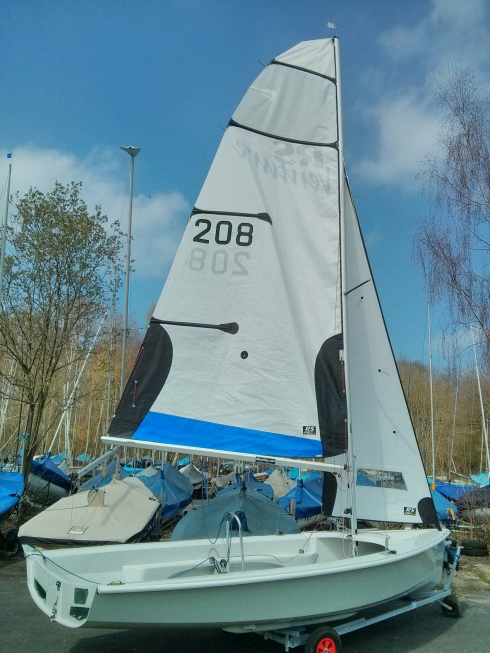RS Venture Boom
Description
The boom is made by Selden and contains the sail track, the outhaul line, the reefing lines, the kicker / gnav blocks and mainsheet blocks. These are described individually below.
The inboard boom end (Part No 509-081-01) consists of the gooseneck coupling to the mast and blocks for the gnav line and reefing / outhaul lines. The latter lines share a single sheeve that requires the lines to be changed over when reefing or adjusting the outhaul. The gooseneck also has a hole through which the downhaul line is passed.
Gnav
The gnav is a slightly unusual design with the 4mm gnav line being led into a cleat system mounted on the mast. The main benefit of this design is that the crew area is largely uncluttered and the crew does not need to avoid kicker lines when tacking. The downside of this design is that the helm would normally need ask the crew to adjust the gnav when necessary. Very good indeed for cruising but not ideal if racing.
The key to this gnav system is the sliding strut mounted on the top of the boom. Pulling on the gnav line operates a system of blocks that slides the base of the gnav strut towards the mast, forcing the rear of the boom down and flattening the sail to improve upwind sailing. The force exerted by this strut is substantial and it is important that it is rigged correctly with the thrust washers correctly placed in the gooseneck and gnav brackets at the mast. Both washers are sited within their bracket. The upper bracket has its washer placed above the inserted bearing and the lower bracket has the washer inserted below the gooseneck bearing.
I have modified the gnav pulley system on my RS Venture. The modification involves inserting an additional 16mm single block into the pulley system to provide a greater purchase (4:1) than the factory system. This makes it very quick and easy to pull on the power when turning upwind. The minor disadvantage is that the additonal block limits the travel distance of the gnav slider. In practice this seems to make very little difference to the efficiency of the sail and I regard the convenience as more than outweighing the very slight loss of maximum pressure.
Outhaul
The outhaul line runs straight through the boom from rear to a cleat fixed at the lower front of the boom. It is a 4mm line a little less than 4m in length (not critical). Convenient modifications involve inserting a booble on the front of the line to make operation easier and prevent the line inadvertently being drawn into the boom. Another very useful modification is to insert a small (16mm) hook block at the rear of the outhaul line. This has two advantages; provides a useful 2:1 purchase on the outhaul and also enables the knot at the end of the outhaul line to be left permanently in situ simplifying rigging in windy cold weather. (See diagram xxxx)
Reefing
The reefing line consists of two 4mm ropes, connected via a loose 16mm pulley block. The rear line is attached to the fixed loop on the pulley block. The two forward lines are in fact a single rope passing over the small pulley inside the boom. When rigged, one end of the forward rope is fed up the forward port side of the sail. The other end is fed into the small pulley block fixed at the lower front of the boom, shared with the outhaul line, and acts as the operating line for the reefing system (See the schematic diagram xxxx).
Maintenance work on the reefing lines can be best done by slackening the two foward lines and then pulling on the rear line, if necessary making sure that the front reefing lines are not inadvertently pulled into the boom. The reefing block will appear at the bottom rear of the boom. Installing a new forward line is made easier by attaching the new line to the old line and pulling through. When replacing the lines the length of the rear line is important to the operation of the reefing system. The rear line should be replaced with a correct length of rope (when the sail is fully reefed and hoisted the loose reefing block should be positioned near to the end of the boom to allow full operation) of the system.
Mainsheet Blocks
These consist of two 40mm Selden blocks (Part No. Selden 40mm Single Strap Block 404-101-02) looped into stainless steel saddle clips firmly riveted into the track at the bottom of the boom. The boom position is not adjustable. The centre holes of the original blocks are limited in width which prevents thick mainsheets from being passed through the centre for alternative rigging options. The original Seldene blocks can be removed without the need to remove the saddle clip rivets (unscrew the strap). Any replacement block must have a removeable strap otherwise the saddle clip rivets will need to be removed, eg. Allen A2040B 40mm bolt block.
